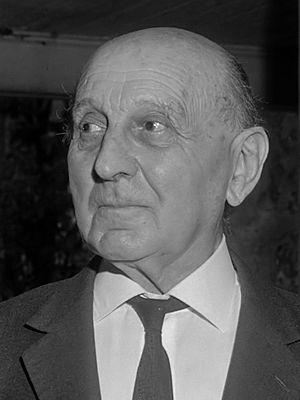Frederik Jacobus Johannes Buytendijk facts for kids
Frederik Jacobus Johannes Buytendijk (born April 19, 1887, died October 21, 1974) was a very smart Dutch scientist. He studied many different things! He was an anthropologist, a biologist, and a psychologist. This means he learned about people, living things, and how our minds work.
Contents
Early Life and Education
Frederik Buytendijk was born in Breda, a city in the Netherlands. He first trained to become a doctor. After that, he started teaching. He taught biology and how the body works at VU University Amsterdam. In 1919, he became a professor there.
Moving to New Roles
In 1924, he moved to Groningen. There, he became a professor of how the body works and how tissues are made. Later, from 1946 until he retired in 1957, he was a special professor in Nijmegen. He also became a professor of psychology in Utrecht. This was interesting because he had never formally studied psychology!
Important Influences and Ideas
When he was younger, Buytendijk met some important thinkers. These included Max Scheler, Hans Driesch, and Helmuth Plessner. Plessner even became his friend. These people greatly influenced his ideas.
Connecting with Great Minds
Frederik Buytendijk also wrote letters to many famous philosophers. Some of these were Binswanger, Guardini, Merleau-Ponty, and even Jean-Paul Sartre and Simone de Beauvoir. This shows he was connected to many of the leading thinkers of his time.
How He Developed His Ideas
Buytendijk got his ideas from different places. Since 1918, he had been studying how animals think and behave. After World War II, he started studying how humans think. He also used something called phenomenology. This is a way of studying things by letting them "speak for themselves." It means looking closely at experiences as they happen.
Body and Mind Together
In 1949, Buytendijk wrote an important book. It was called General Theory of Human Posture and Movement. In this book, he showed how our bodies and minds work together. He believed you cannot separate them when you study human behavior.
Later Life and Contributions
In 1937, Frederik Buytendijk became Catholic. He was very involved in his community. He even became the chairman of the Catholic Association for Mental Health. This group helped people with their mental well-being.
Sharing Knowledge
From the late 1950s, he was also the main editor for the Aula series. This was a popular series of science books. They were paperbacks, which made them easy for many people to read. He wrote many books and articles himself. One of his well-known books was De Vrouw (The Woman), published in 1951.
See also
 In Spanish: Frederik J. J. Buytendijk para niños
In Spanish: Frederik J. J. Buytendijk para niños


